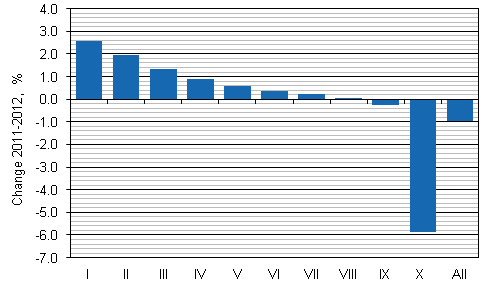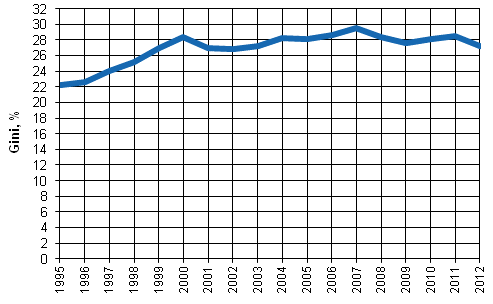This set of statistics has been discontinued.
Statistical data on this topic are published in connection with another set of statistics.
Data published after 5 April 2022 can be found on the renewed website.
Published: 18 December 2013
Income differentials narrowed in 2012
Statistics Finland's total statistics on income distribution show that income differentials narrowed in 2012 compared with the previous year. The narrowing of differentials was due to the reduced income of high-income groups and the growing income of low-income groups. The real income of the highest-income decile went down by 5.9 per cent from 2011 to 2012. This is a result of reductions in realised capital gains and dividend income. The income level of the lowest-income decile rose in real terms by 2.6 per cent from the year before. This was influenced by the level increases of social benefits and changes in taxation.
Change in average real income (%) by income decile from 2011 to 2012

Income decile: the population is arranged according to income and divided into ten equal parts, each of which has around half a million persons. Income decile I is the lowest-income decile and income decile X the highest-income decile. The changes are calculated per average person. Income concept: the household-dwelling unit's disposable money income per consumption unit.
The Gini index describing relative income differentials was more or less at the same level as ten years ago. It went down by 1.3 percentage points from 2011 to 2012 and received the value 27.2. Compared with 1995, the Gini coefficient has grown considerably, or by around five percentage points, most of which is caused by growing income differentials in the late 1990s. Measured with the Gini coefficient, income differentials were at their largest in 2007, compared to which the Gini coefficient for 2012 was 2.3. percentage points lower. The Gini coefficient gets the value 0 if everyone receives the same amount of income and 100 if one income recipientr receives all the income. The smaller the Gini coefficient, the smaller the income differentials are.
Development of income inequality 1995– 2012, Gini index (%).

Persons belonging to the household-dwelling population, the household-dwelling unit's disposable money income per consumption unit.
Source: Total statistics on income distribution, Statistics Finland
Inquiries: Veli-Matti Törmälehto 09 1734 3680
Director in charge: Harala Riitta
- Tables
-
Tables in databases
Pick the data you need into tables, view the data as graphs, or download the data for your use.
Updated 18.12.2013
Official Statistics of Finland (OSF):
Total statistics on income distribution [e-publication].
Income inequality 2012. Helsinki: Statistics Finland [referred: 16.4.2024].
Access method: http://www.stat.fi/til/tjkt/2012/02/tjkt_2012_02_2013-12-18_tie_002_en.html

